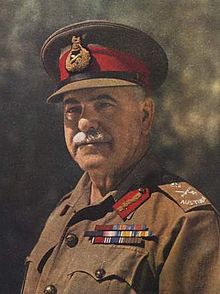
Back توماس بلامي Arabic توماس بلامى ARZ تۆماس بلامی CKB Thomas Blamey German Thomas Blamey Spanish توماس آلبرت بلمی Persian Thomas Blamey French תומאס בליימי HE Thomas Blamey ID Thomas Blamey JV
Sir Thomas Blamey | |
|---|---|
 Blamey in 1942 | |
| Born | 24 January 1884 Wagga Wagga, Colony of New South Wales |
| Died | 27 May 1951 (aged 67) Heidelberg, Victoria, Australia |
| Buried | Fawkner Memorial Park, Victoria |
| Allegiance | Australia |
| Service/ | Australian Army |
| Years of service | 1906–1950 |
| Rank | Field marshal |
| Service number | VX1 (2nd AIF) |
| Commands held |
|
| Battles/wars | |
| Awards | |
| 10th Chief Commissioner of Victoria Police | |
| In office 1 September 1925 – 9 July 1936 | |
| Monarchs | |
| Governor | |
| Preceded by | Alexander Nicholson |
| Succeeded by | Alexander Duncan |
Field Marshal Sir Thomas Albert Blamey, GBE, KCB, CMG, DSO, CStJ, ED (24 January 1884 – 27 May 1951) was an Australian general of the First and Second World Wars. He is the only Australian to attain the rank of field marshal.
Blamey joined the Australian Army as a regular soldier in 1906, and attended the Staff College at Quetta. During the First World War he participated in the landing at Anzac Cove on 25 April 1915, and served as a staff officer in the Gallipoli campaign, where he was mentioned in despatches for a daring raid behind enemy lines. He later served on the Western Front, where he distinguished himself in the planning for the Battle of Pozières. He rose to the rank of brigadier general, and served as chief of staff of the Australian Corps under Lieutenant General Sir John Monash, who credited him as a factor in the Corps' success in the Battle of Hamel, the Battle of Amiens and the Battle of the Hindenburg Line.
After the war Blamey became the Deputy Chief of the General Staff, and was involved in the creation of the Royal Australian Air Force. He resigned from the regular Army in 1925 to become Chief Commissioner of the Victoria Police, but remained in the Militia, rising to command the 3rd Division in 1931. As chief commissioner, Blamey set about dealing with the grievances that had led to the 1923 Victorian police strike, and implemented innovations such as police dogs and equipping vehicles with radios. His tenure as chief commissioner was marred by a scandal in which his police badge was found in a brothel, and a later attempt to cover up the shooting of a police officer led to his forced resignation in 1936.
During the Second World War Blamey commanded the Second Australian Imperial Force and the I Corps in the Middle East. In the latter role he commanded Australian and Commonwealth troops in the disastrous Battle of Greece. He attempted to protect Australian interests against British commanders who sought to disperse his forces. He was appointed deputy commander-in-chief of Middle East Command, and was promoted to general in 1941. In 1942, he returned to Australia as commander-in-chief of the Australian Military Forces and commander of Allied Land Forces in the South West Pacific Area under American General Douglas MacArthur. On the orders of MacArthur and Prime Minister John Curtin, he assumed personal command of New Guinea Force during the Kokoda Track campaign, and relieved Lieutenant General Sydney Rowell under controversial circumstances. He planned and carried out the significant and victorious Salamaua–Lae campaign but during the final campaigns of the war he faced criticism of the Army's performance. He signed the Japanese Instrument of Surrender on behalf of Australia at Japan's ceremonial surrender in Tokyo Bay on 2 September 1945, and personally accepted the Japanese surrender on Morotai on 9 September.
© MMXXIII Rich X Search. We shall prevail. All rights reserved. Rich X Search